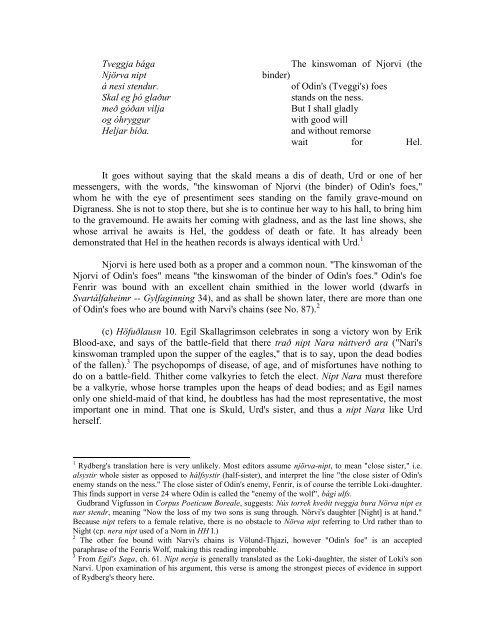Chapters 44-95 - Germanic Mythology
Chapters 44-95 - Germanic Mythology
Chapters 44-95 - Germanic Mythology
You also want an ePaper? Increase the reach of your titles
YUMPU automatically turns print PDFs into web optimized ePapers that Google loves.
Tveggja bága<br />
Njörva nipt<br />
á nesi stendur.<br />
Skal eg þó glaður<br />
með góðan vilja<br />
og óhryggur<br />
Heljar bíða.<br />
The kinswoman of Njorvi (the<br />
binder)<br />
of Odin's (Tveggi's) foes<br />
stands on the ness.<br />
But I shall gladly<br />
with good will<br />
and without remorse<br />
wait for Hel.<br />
It goes without saying that the skald means a dis of death, Urd or one of her<br />
messengers, with the words, "the kinswoman of Njorvi (the binder) of Odin's foes,"<br />
whom he with the eye of presentiment sees standing on the family grave-mound on<br />
Digraness. She is not to stop there, but she is to continue her way to his hall, to bring him<br />
to the gravemound. He awaits her coming with gladness, and as the last line shows, she<br />
whose arrival he awaits is Hel, the goddess of death or fate. It has already been<br />
demonstrated that Hel in the heathen records is always identical with Urd. 1<br />
Njorvi is here used both as a proper and a common noun. "The kinswoman of the<br />
Njorvi of Odin's foes" means "the kinswoman of the binder of Odin's foes." Odin's foe<br />
Fenrir was bound with an excellent chain smithied in the lower world (dwarfs in<br />
Svartálfaheimr -- Gylfaginning 34), and as shall be shown later, there are more than one<br />
of Odin's foes who are bound with Narvi's chains (see No. 87). 2<br />
(c) Höfuðlausn 10. Egil Skallagrimson celebrates in song a victory won by Erik<br />
Blood-axe, and says of the battle-field that there trað nipt Nara náttverð ara ("Nari's<br />
kinswoman trampled upon the supper of the eagles," that is to say, upon the dead bodies<br />
of the fallen). 3 The psychopomps of disease, of age, and of misfortunes have nothing to<br />
do on a battle-field. Thither come valkyries to fetch the elect. Nipt Nara must therefore<br />
be a valkyrie, whose horse tramples upon the heaps of dead bodies; and as Egil names<br />
only one shield-maid of that kind, he doubtless has had the most representative, the most<br />
important one in mind. That one is Skuld, Urd's sister, and thus a nipt Nara like Urd<br />
herself.<br />
1 Rydberg's translation here is very unlikely. Most editors assume njörva-nipt, to mean "close sister," i.e.<br />
alsystir whole sister as opposed to hálfsystir (half-sister), and interpret the line "the close sister of Odin's<br />
enemy stands on the ness." The close sister of Odin's enemy, Fenrir, is of course the terrible Loki-daughter.<br />
This finds support in verse 24 where Odin is called the "enemy of the wolf", bági ulfs.<br />
Gudbrand Vigfusson in Corpus Poeticum Boreale, suggests: Nús torrek kveðit tveggja bura Nörva nipt es<br />
nær stendr, meaning "Now the loss of my two sons is sung through. Nörvi's daughter [Night] is at hand."<br />
Because nipt refers to a female relative, there is no obstacle to Nörva nipt referring to Urd rather than to<br />
Night (cp. nera nipt used of a Norn in HH I.)<br />
2 The other foe bound with Narvi's chains is Völund-Thjazi, however "Odin's foe" is an accepted<br />
paraphrase of the Fenris Wolf, making this reading improbable.<br />
3 From Egil's Saga, ch. 61. Nipt nerja is generally translated as the Loki-daughter, the sister of Loki's son<br />
Narvi. Upon examination of his argument, this verse is among the strongest pieces of evidence in support<br />
of Rydberg's theory here.
















